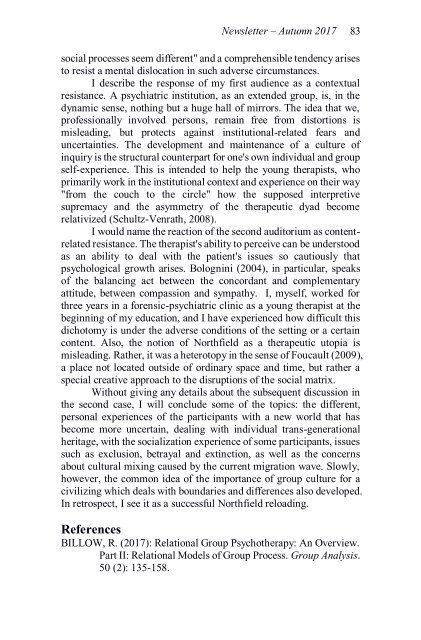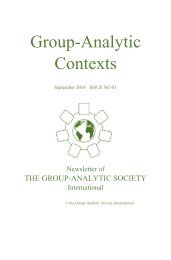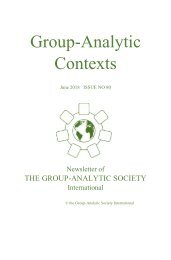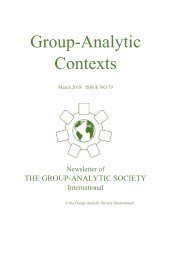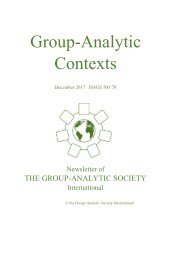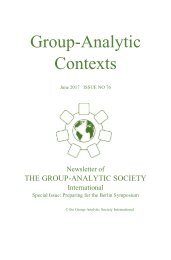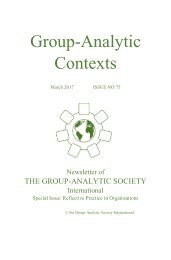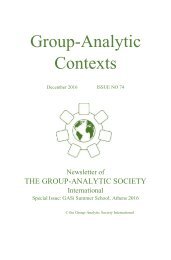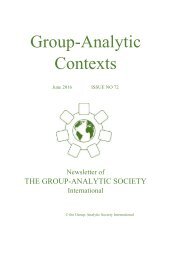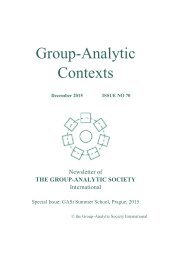Group Analytic Contexts, Issue 77, September 2017
Newsletter of the Group Analytic Society International
Newsletter of the Group Analytic Society International
You also want an ePaper? Increase the reach of your titles
YUMPU automatically turns print PDFs into web optimized ePapers that Google loves.
Newsletter – Autumn <strong>2017</strong> 83<br />
social processes seem different" and a comprehensible tendency arises<br />
to resist a mental dislocation in such adverse circumstances.<br />
I describe the response of my first audience as a contextual<br />
resistance. A psychiatric institution, as an extended group, is, in the<br />
dynamic sense, nothing but a huge hall of mirrors. The idea that we,<br />
professionally involved persons, remain free from distortions is<br />
misleading, but protects against institutional-related fears and<br />
uncertainties. The development and maintenance of a culture of<br />
inquiry is the structural counterpart for one's own individual and group<br />
self-experience. This is intended to help the young therapists, who<br />
primarily work in the institutional context and experience on their way<br />
"from the couch to the circle" how the supposed interpretive<br />
supremacy and the asymmetry of the therapeutic dyad become<br />
relativized (Schultz-Venrath, 2008).<br />
I would name the reaction of the second auditorium as contentrelated<br />
resistance. The therapist's ability to perceive can be understood<br />
as an ability to deal with the patient's issues so cautiously that<br />
psychological growth arises. Bolognini (2004), in particular, speaks<br />
of the balancing act between the concordant and complementary<br />
attitude, between compassion and sympathy. I, myself, worked for<br />
three years in a forensic-psychiatric clinic as a young therapist at the<br />
beginning of my education, and I have experienced how difficult this<br />
dichotomy is under the adverse conditions of the setting or a certain<br />
content. Also, the notion of Northfield as a therapeutic utopia is<br />
misleading. Rather, it was a heterotopy in the sense of Foucault (2009),<br />
a place not located outside of ordinary space and time, but rather a<br />
special creative approach to the disruptions of the social matrix.<br />
Without giving any details about the subsequent discussion in<br />
the second case, I will conclude some of the topics: the different,<br />
personal experiences of the participants with a new world that has<br />
become more uncertain, dealing with individual trans-generational<br />
heritage, with the socialization experience of some participants, issues<br />
such as exclusion, betrayal and extinction, as well as the concerns<br />
about cultural mixing caused by the current migration wave. Slowly,<br />
however, the common idea of the importance of group culture for a<br />
civilizing which deals with boundaries and differences also developed.<br />
In retrospect, I see it as a successful Northfield reloading.<br />
References<br />
BILLOW, R. (<strong>2017</strong>): Relational <strong>Group</strong> Psychotherapy: An Overview.<br />
Part II: Relational Models of <strong>Group</strong> Process. <strong>Group</strong> Analysis.<br />
50 (2): 135-158.


